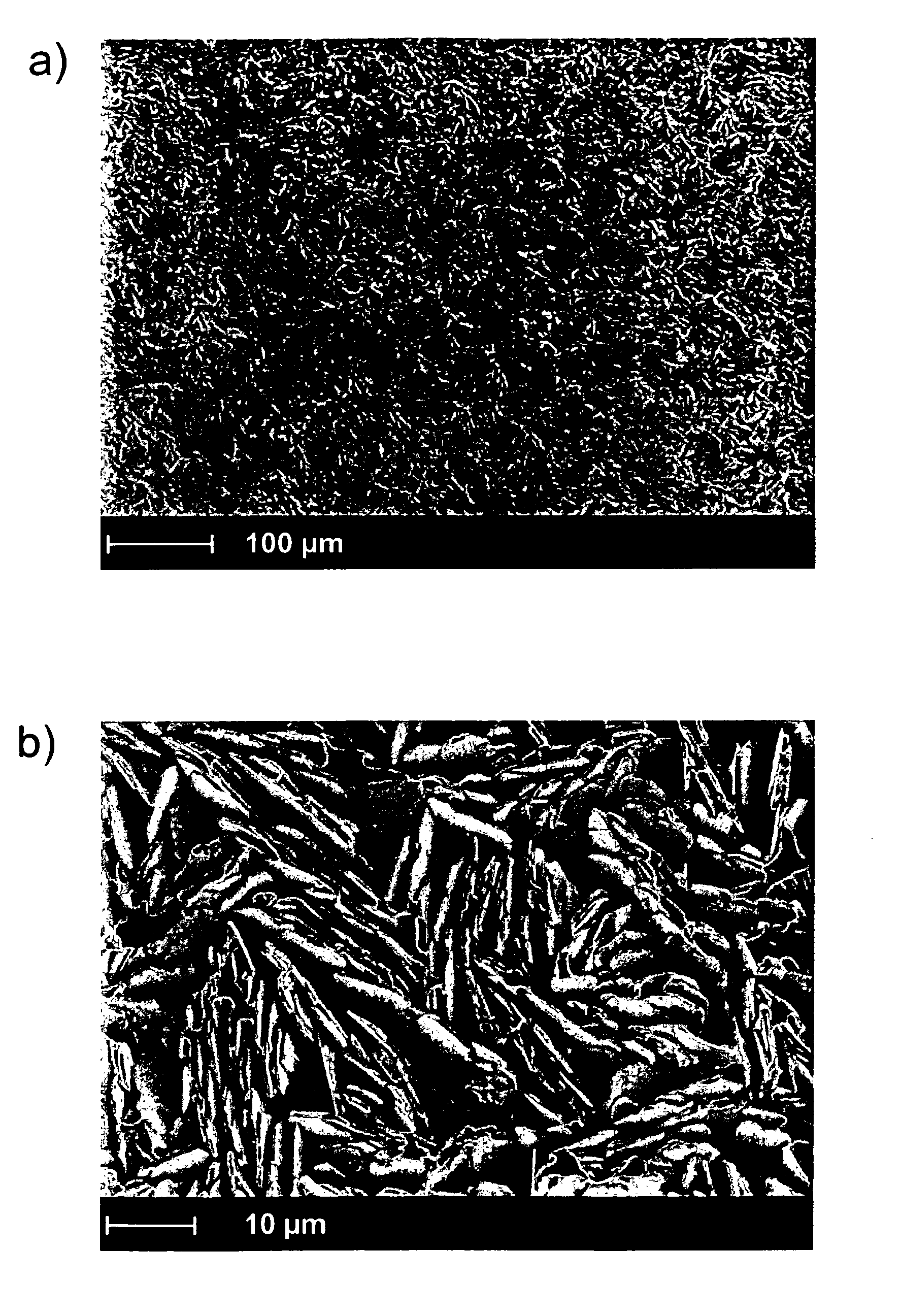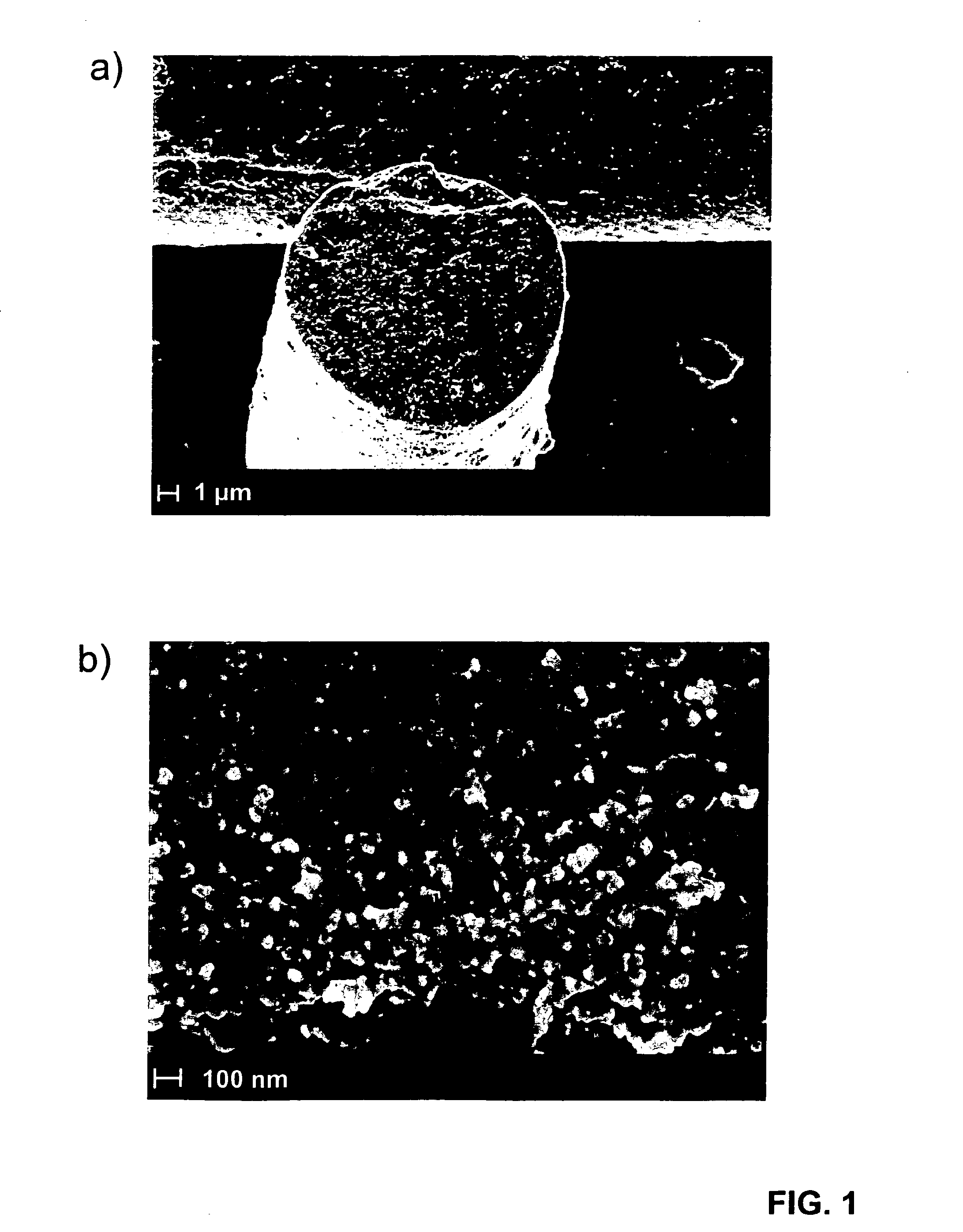Method for the production of reinforced materials and reinforced materials obtained using this method
a technology of reinforced materials and production methods, applied in the direction of impression caps, prosthesis, adhesive types, etc., can solve the problems of delamination being one of the major causes of failure in advanced composites, the specific direction of reinforcement provided by each single particle, and the difficulty of deliberate reinforcement in three dimensions, etc., to achieve effective alignment, improve the effect of actual reinforcement, and strengthen the attachmen
- Summary
- Abstract
- Description
- Claims
- Application Information
AI Technical Summary
Benefits of technology
Problems solved by technology
Method used
Image
Examples
example 1
[0101]Out-of-plane reinforced thermoplastic polymer films produced with alumina platelets, iron oxide nanoparticles and polyurethane as reinforcing particles, magnetic particles and thermoplastic matrix polymer, respectively.
[0102]1. 50 mL of 10%wt thermoplastic polyurethane (PU, Estallon C64) in dimethylformamide (DMF) solution is made and stirred for 30 hours at 60 C.
[0103]2. Meanwhile 200 μL of the 12 nm anionic EMG 705 iron oxide nanoparticle solution from Ferrotec is diluted in 20 mL of pH 7 deionized water. 5 g of commercial 7.5 μm aluminum oxide platelets (Al Pearl, Antaria) are added to the solution and allowed to electrostatically adsorb the magnetic nanoparticles for 24 hours. Then, the platelets are allowed to sediment in the solution and the supernatant is removed and rinsed several times to remove free-floating magnetic nanoparticles.
[0104]3. The magnetized platelets are then added at a concentration of 2% Vol to the PU. The solution is thoroughly stirred for 2 hours an...
example 2
[0108]Out-of-plane reinforced thermoset polymer film produced with alumina platelets, iron oxide nanoparticles and epoxy resin as reinforcing particles, magnetic particles and thermoset matrix polymer, respectively.
[0109]1. 200 μL of the 12 nm cationic EMG 605 iron oxide nanoparticle solution from Ferrotec is diluted in 20 mL of deionized water at pH 7 to form an aqueous suspension. 5 g of commercial 7.5 μm aluminum oxide platelets (Al Pearl, Antaria) are surface modified with 3-aminopropyltriethoxysilane and / or epoxy-functional silane (gamma-Glycidoxypropyltrimethoxysilane) to enable strong adhesion to the epoxy matrix. The resulting modified alumina platelets are afterwards added to the aqueous suspension and allowed to electrostatically adsorb the magnetic nanoparticles for 24 hours. Then, the platelets are allowed to sediment in the solution and the supernatant is removed and rinsed several times to remove free-floating magnetic nanoparticles.
[0110]2. 10 g of epoxy resin (Araldi...
example 3
[0113]Out-of-plane reinforced thermoset polymer film produced with glass fibers, iron oxide nanoparticles and epoxy resin as reinforcing particles, magnetic particles and thermoset matrix polymer, respectively.
[0114]1. 200 μL, of the 12 nm cationic EMG-605 iron oxide nanoparticle solution from
[0115]Ferrotec is diluted in 20 mL of deionized water at pH 7. 5g of commercial short glass fibers (FibreGlast Corp. 1 / 32″ milled fibers, 10 μm in diameter and 0.1-10 mm in length) surface modified to obtain strong adhesion with epoxy resins are added to the aqueous suspension and allowed to electrostatically adsorb the magnetic nanoparticles for 24 hours. Then, the fibers are allowed to sediment in the solution and the supernatant is removed and rinsed several times to remove free-floating magnetic nanoparticles.
[0116]2. 10 g of epoxy resin (Araldite GY 250, Huntsman) is mixed with 9 g of an anhydride-based crosslinker (Araldur 917, Huntsman) and 0.2 g of the catalyst (Accelerator DY 070, Hunt...
PUM
| Property | Measurement | Unit |
|---|---|---|
| weight ratio | aaaaa | aaaaa |
| length | aaaaa | aaaaa |
| average diameter | aaaaa | aaaaa |
Abstract
Description
Claims
Application Information
 Login to View More
Login to View More - R&D
- Intellectual Property
- Life Sciences
- Materials
- Tech Scout
- Unparalleled Data Quality
- Higher Quality Content
- 60% Fewer Hallucinations
Browse by: Latest US Patents, China's latest patents, Technical Efficacy Thesaurus, Application Domain, Technology Topic, Popular Technical Reports.
© 2025 PatSnap. All rights reserved.Legal|Privacy policy|Modern Slavery Act Transparency Statement|Sitemap|About US| Contact US: help@patsnap.com



